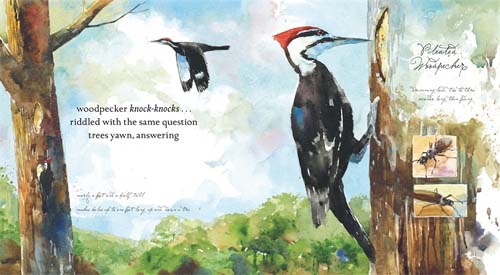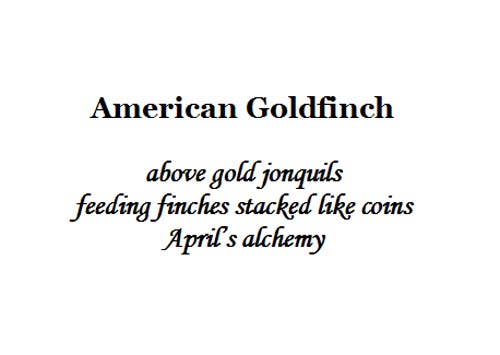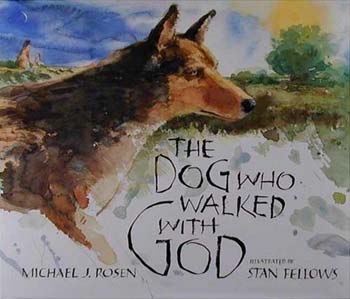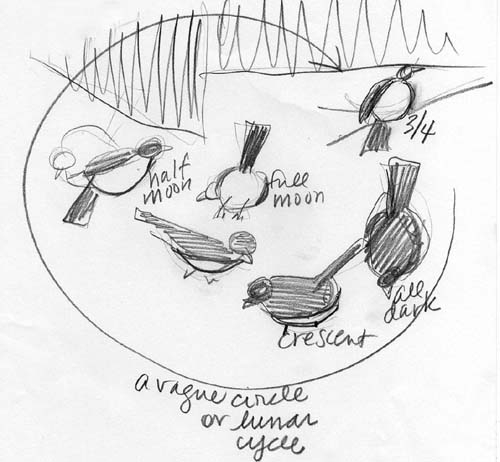Poetry Friday and Michael J. Rosen:
Haiku is for the Birds
 February 27th, 2009 by jules
February 27th, 2009 by jules

 There’s this book. It’s called The Cuckoo’s Haiku: And Other Birding Poems (Candlewick). It was written by the very prolific Michael J. Rosen and illustrated with remarkable grace by Stan Fellows and will be released very, very soon — in March. This poetry volume is designed to be not unlike a field notebook on birds — twenty-four North American birds from the Eastern Bluebird to the Dark-Eyed Junco — divided by seasons, starting with Spring and ending with Winter. (The Pileated Woodpecker opens this post.) A spare, evocative haiku from the mind and observant eye of Rosen accompanies each bird (“first feeders at dawn / paired like red quotation marks / last feeders at dusk” is the entry for the Northern Cardinal), as well as lush and—there’s no other word for it—beautiful watercolors from Fellows of these birds in their habitats that just shimmer right off the page. (His illustrations even include Rosen’s ardent notes about these creatures of the air. My favorites are on the American Goldfinch spreads: “travel in small groups, feeder is a tower of gold” and “funny — their song is ‘potato-chips, potato-chips.'”)
There’s this book. It’s called The Cuckoo’s Haiku: And Other Birding Poems (Candlewick). It was written by the very prolific Michael J. Rosen and illustrated with remarkable grace by Stan Fellows and will be released very, very soon — in March. This poetry volume is designed to be not unlike a field notebook on birds — twenty-four North American birds from the Eastern Bluebird to the Dark-Eyed Junco — divided by seasons, starting with Spring and ending with Winter. (The Pileated Woodpecker opens this post.) A spare, evocative haiku from the mind and observant eye of Rosen accompanies each bird (“first feeders at dawn / paired like red quotation marks / last feeders at dusk” is the entry for the Northern Cardinal), as well as lush and—there’s no other word for it—beautiful watercolors from Fellows of these birds in their habitats that just shimmer right off the page. (His illustrations even include Rosen’s ardent notes about these creatures of the air. My favorites are on the American Goldfinch spreads: “travel in small groups, feeder is a tower of gold” and “funny — their song is ‘potato-chips, potato-chips.'”)
It’s a thing of beauty, this book.
“phased like tilted moons /
half shadow, half reflection / juncos cross the snow”
Two things happen when I see books like this, books I fall in love with. First, I feel inadequate to convey the spirit of the book, the reasons for which I think it’s an outstanding book in one way or another. If I feel this way about the art, for instance, I usually go begging at the publisher’s cyber-door to see if I can secure permission to share a spread or two from it. The art speaks way louder than I can. Secondly, I usually end up wanting to chat with the creator(s). Sometimes, though, my schedule precludes me from doing what I want, or: I just ain’t got the time, what with chasing two young children around and doing the job-that-pays. Other times—like this week—I’ll have a sudden inspiration that goes not unlike this: Oh yeah, it’s my turn for Poetry Friday. I just HAVE TO post about this kickin’ book this week THIS Friday. MUST. So, it is, say, mid-week, and I’m having this epiphany. Not a lot of time to prep, huh? This is the way I roll.
So, that’s why I’m grateful to people like poet and author (and editor and illustrator and birder, of course) Michael J. Rosen, who obliged my request to stop by today and do another in-their-own-words type of post. I gave him free reign to talk about the creation of this set of poems, and I also asked him specifically what it was like to see Fellows’ art for the first time. I appreciate this more than I can say, not only because I very much enjoyed reading what he had to say (I mean to tell you that, boy howdy and howdy boy, he took this and ran with it — just exactly as I had hoped he would), but also because he’s…well, he’s made it easy for me, what with my busy schedule this week. I can still get my work-work done yet also give you a glimpse into what I think is such a dazzling book. Perhaps one day Rosen and/or Fellows can stop by for one of those wacky breakfast chats. But, for now, I raise my coffee mug to this book. Before breakfast even.
If you aren’t already a birder, this book makes you damn well want to be one, all thanks to Rosen’s “practiced gaze” (the importance of which, if you keep reading, you’ll understand). Let’s get right to it then — Michael J. Rosen in his own words, that is. Many thanks again to him, Candlewick (for the art), and Stan Fellows.
“There’s so much to say about this, and thanks to you for inviting me to share some time—if not your actual coffee pot—with your community here.
So, yes, it’s always funny to write at length about something that’s short. As in explaining humor, there’s also the risk of ‘killing the joke’ that comes with the territory. But I’ll try to offer some insights into what I had in mind. And just to make this readable on a blog, I’ll make some short paragraphs on different aspects.
Wildlife
When I was twelve, my family built a house in a new development. We were one of the first houses in what had been a cow pasture. Every summer, I had been going to camp, and the grounds around our new house felt as if I’d moved to that camp. Sure, the horses, sailboats, and counselors were missing, but not the wildflowers, cocoons, quartz stones, poison ivy, cattails crowned with red-winged blackbirds, raspberry brambles, secret forts…
Additionally, my father took us fishing or for some sort of ride in the country, most every weekend.
Now I live on a 100-acre farm in the foothills of the Appalachians.
Writing about wildlife is really writing about my own life.
“the great oak’s tresses /
beaded with cedar waxwings / wind tossing its head”
Ornithology
I was a zoology major in college. Pre-med. I took two classes in ornithology with a veteran professor, Dr. Putnam, which included lectures, labs, and most of all, pre-dawn field trips to bird-watching ‘hot spots’ all over Ohio. Before those classes, I generalized all birds into the lump-sum category, ‘bird.’ I mean, I knew a duck from a robin, but, like most people, until we learn to really look at something, we don’t see much. Be that classical music, ballet, or architecture. Could you be a judge at a dog show, choosing the best corgi out of a pack of 100 corgis? Would you be able to tell what high-school wrestler had the wherewithal to become a great pro wrestler? The answer is yes, once you trade your innocent, distracted, well-meant impressions for a more precise, exhausting, vocabulary-rich, practiced gaze.
Poetry
I left medical school after six months. I had been writing poetry all along, ever since junior high school. (Admittedly, that ‘early stuff’ was little more than hanging around words and writing them in fancy lettering in sketchbooks.) I attended three writers’ conferences at Bread Loaf, and then went for an MFA at Columbia.
In all that time, I never wrote haiku. I had read a bit of it. But there were no haiku in any of my three volumes of poetry for adults or in any of the books I’ve done to-date for younger readers. It could be that I’m longer-winded than seventeen-syllables allows. It could be that I’m more drawn to narrative forms, to tone, to humor, to cumulative power.
But this changed after my father died, shortly before 9/11.
Also true: I had no idea about haiku until I began reading and rereading the best of it, until I learned how strange and wonderful that form has been in the hands of a genuine master, and how challenging it is in the hands of anyone else, myself included.

Haiku
My father died rather suddenly at the age of 71. Grief and family responsibilities around that time kept me from concentrating long and hard on much of anything. I managed to do e-mail and pedestrian editing, but nothing creative or expansive. Yet, for me, writing is always a way of regaining ground, of slowing down my racing thoughts. As Auden wrote of poetry, it’s ‘clear thinking about mixed feelings.’
The shortness of this form proved meditative. For being so brief, it is nevertheless very long in realizing its prismatic clarity. (It’s easy to be vague and cloudy, but time-consuming—at least for me—to hone those few words into something that reveals!) So I could take notes, create alternative versions, polish a line or two, and then hold that image or set of images in my head while walking or working. I could write and rewrite almost like reciting a calming, but evolving, mantra. And I could also move on to something else or to another attempt at a different haiku if I felt frustrated by a given poem. I could begin several in the same day, moving them like checker pieces across the board…making several plays with one haiku, leaving another to the side, shifting to a third in order to provide a little time or renewed perspective on the first one.
Birds
I probably wrote 200 haiku in a few months. Maybe drafts of another hundred or so that I never fully realized. Nearly all were about the natural world: dogs and cats; rural or small town observations; wildflowers, insects, and other seasonal phenomena; the meadows, farm pond, and tree-covered landscape I share with deer; migrating and resident birds, possums, raccoons; and so on.
My editor at Candlewick read many of these, and I tried a number of selections from that loose collection. A grouping about familiar birds, complete with what we’ve called field notes—observations about behaviors, songs, colors, and so forth—gelled into the most feasible book. So we culled out about 25 poems, and I wrote field notes both for the pages’ sketches, as well as for a few pages in the back of the book. They touch on what I find most engaging about the species featured in the book, as well as on the poems themselves, sharing a bit of what I was seeing or hoping to show.
On What it Was Like to See Stan’s
Art Work for the First Time
I’ve been a passionate admirer and supporter of Stan’s artwork for more than 15 years. His editorial illustrations first persuaded me to write him to contribute to a book I did with Harcourt entitled Speak! Children’s Book Illustrators Brag About Their Dogs. I love the fluid nature of his line drawings, the chromatic vibrancy he manages to achieve in watercolor, the balance and saturated/finished areas of a piece, and the lightly penciled/implied areas.
As an amateur illustrator myself, I’m in awe of that practiced talent that can reveal itself as pure spontaneity. It’s the pure delight that seeming simplicity confers because there’s nothing but painstaking apprenticeship that creates it. Of course, this is exactly what I hoped to achieve with the form of haiku: something seemingly easy and effortless that can only exist because of previous and concealed life-long efforts.
 Meanwhile, I’m just an advocate, a grateful collaborator, someone who relishes the idea of striking until the iron is hot. In other words, when I feel strongly about good things, I try to make them happen. My editor at Candlewick welcomed my input on possible illustrators for an earlier book, The Dog Who Walked with God, and Stan created incredible images for that retelling of a Kato people creation story. It’s a story set in a world of water, and his watercolors themselves grew more and more and more vivid and detailed as the world itself comes into being. While it’s out of print at this point, it’s surely one of the most sublime and fully realized picture books I’ll ever be fortunate enough to create. His watercolors for that book were luminous, devotedly detailed with natural history, and powerfully evocative.
Meanwhile, I’m just an advocate, a grateful collaborator, someone who relishes the idea of striking until the iron is hot. In other words, when I feel strongly about good things, I try to make them happen. My editor at Candlewick welcomed my input on possible illustrators for an earlier book, The Dog Who Walked with God, and Stan created incredible images for that retelling of a Kato people creation story. It’s a story set in a world of water, and his watercolors themselves grew more and more and more vivid and detailed as the world itself comes into being. While it’s out of print at this point, it’s surely one of the most sublime and fully realized picture books I’ll ever be fortunate enough to create. His watercolors for that book were luminous, devotedly detailed with natural history, and powerfully evocative.
So, in many ways, I had an idea of what Stan might create for this new book.
And I did see the sketches for each painting. I did contribute ideas as well as tentatively-worded suggestions, since the natural history the poems and notes alluded to had to be present in the art work. For instance, when I spoke of the junco’s black-and-white patterns that make them look like phases of the moon, the art director and illustrator weren’t sure how to communicate this. After an e-mail describing it more, I drew a little sketch to suggest how the birds could be quarter-, half-, and full moons.

They shared that with Stan, and he worked up his own version {above in this post}, for which I’m certainly glad! So throughout the process the art director, editor, and illustrator all shared conversations, JPEGs of works in various stages of completeness, and so forth. Primarily, my job was to be the ornithologist (the amateur birdwatcher, more like it), and point out any subtle problem that true birders would pick up on in the exuberant colorations that Stan creates. For instance, less orange on the cedar waxwings, more white on the mockingbird’s tail feathers, duller red on the female cardinal.
As a finished work, I couldn’t be more pleased. From the trim size, that makes the book appeal both to older and younger readers, to the seasonal dividers that provide a wash of changing colors to cluster the poems and allow the eyes and imagination to refresh a moment, the team involved in creating this book did an inspired job.“
Thanks again to Michael. For more on the book, you can visit his web site, Fidosopher, and click on “Books for Older Kids & Young Adults.” Clicking the book’s title takes you to his page on it, including the full text of two (thus far) starred reviews from both Kirkus and Publishers Weekly. At that page, he also talks about the similarities between bird-watching and haiku (“Seeing a bird is often a quick impression. Not a complete story, not a close-up, detailed depiction, but, more often, an impression. That’s what haiku can create. And when it comes to birds such as mourning doves or robins, which most of us see fairly frequently, haiku can be a chance to look again, to see something that will turn the common sighting into something astonishing.”)
And don’t miss illustrator Stan Fellows’ Sketchbook. Beautiful watercolors on display.
Today’s Poetry Friday round-up is being held over at Mommy’s Favorite Children’s Books.
THE CUCKOO’S HAIKU. Text copyright © 2009 Michael J. Rosen. Illustrations copyright © 2009 Stan Fellows. Reproduced by permission of the publisher, Candlewick Press, Somerville, MA.

Sold! Gotta have this book! I can’t wait to see how the junco illustration turned out — love the sketch and the whole phases of the moon concept. Reading this book will help me be a more observant birder!
I’m thinking my mom and dad would love this book. (My dad did not leave med school—he became a surgeon— but he’s always been an admirer of poetry and a birdwatcher too.)
I just saw a pileated woodpecker yesterday — was so surprised to see it at the beginning of this post !
This book looks gorgeous; I’m an amateur birder and love those fleeting moments Rosen has captured in his haiku. The goldfinches = perfection. Definitely on my must-buy list! Thanks.
Omigod. I must have that book. ASAP. Also? I am now completely in love with Michael Rosen. Not that I didn’t have a little poetry crush before, but his answers and explications were completely and utterly honest and charming (and quoteskimmable!).
Yes, guys, if you know birders, this is a lovely book for them. If they like poetry, too, they will swoon.
Kelly, yes, I enjoyed reading his responses when I got them in, too. If you quoteskim, just don’t forget the “J”! As I mentioned in this post last February, Rosen gets confused with the other, non-J Michael all the time.
Ooh – thanks for that reminder, Jules. Will remember the J. (And now, brainradio is playing “J for Jules” – what a coincidence!)
Thanks for the sparkling, rich images and words. And what an enlightening Auden quote.
Lust. I am lusting after this book. It’s debut comes approximately one year after I started bird-watching–the perfect gift to myself for my birdiversary.
Thank you, Jules, for this amazing post! I do believe y’all channel my book desires…
WOW! And WOW again.
Thanks so much for bringing this book to our attention and for sharing Michael J. Rosen’s own words. Always fascinating to hear creators talk about their work, even when the work speaks for itself.
“The answer is yes, once you trade your innocent, distracted, well-meant impressions for a more precise, exhausting, vocabulary-rich, practiced gaze.”
Is that not a perfect sentence?
Also, this book looks like Just the Thing for my library.
Oh, bowl me over.
Exquisite.
The book.
The answers.
The birds…
Now this is cool: Poetry Friday and an author kinda-interview rolled into one. Thanks, Jules, for putting it together — and thanks to Michael J. Rosen for the wonderful thinkings-out-loud! (Auden’s bit about poetry = “clear thinking about mixed feelings” — never heard that before but LOVE it.)
When I read that American goldfinches say “potato chips, potato chips,” I broke into a big grin. I must’ve been an American goldfinch in another life.
From the fidosopher Web site (thanks for the link!), I learned of Rosen’s book 101 Damnations: The Humorists’ Tour of Personal Hells. With that title alone, I shall sail into the weekend feeling fulfilled. 🙂
Outstanding! I’ve followed your work for severl years through your Dad, Dan Olson.
MORE!
These responses are impossibly wonderful to hear. They have made my day, week…(we’ll see how long it lasts)! Reading this review this morning, I walked the dogs and a mob of crows—the largest I’ve seen or heard on this property—had gathered in the tops of many enormous hemlocks on the farm. They were cawing, cawing, cawing at such a volume, that even the new dog, a great Pyrenees, was seriously frightened. I could only see a few of the birds lifting up and settling back down; the majority of the mob was interior. A hundred, two hundred crows? But the amazing thing, other than the volume, is that the cacophony of all those individual caws shaped into a rhythm every so many seconds. A chorus cheer, rather than all chaos. And the sound repeatedly took that shape, as when at a stadium, the raucous crowd suddenly joins in a particular cheer. We stood there for fifteen minutes, listening to how the birds’ calls veered into and out of that rhythm.
Of course, they were probably mobbing an owl. Or…? I’m not sure. As I say, I’ve never seen so many at one gathering, never heard such a volume. As when the cicadas erupted several years ago.
My conclusion: They were cheering on the day. They’d heard of the 7 Impossible Things feature. They were applauding you all as well.
Caw, caw, from Ohio,
Michael
P.S. For folks who don’t know Auden’s prose, THE DYER’S HAND is a marvelous book on reading, thinking, poetry, Shakespeare…most everything. It became a way of seeing for me.
WOW. What gorgeous watercolors. Again, what poetry! Once again, I find myself wishing for skill in painting.
That looks like a gorgeous book. What beautiful haikus and illustrations! Thank you for the recommendation!
What a wonderful book, birds and Haiku together. I will also have to find “The Dog Who Walked With God”.
[…] Seven Impossible Things Before Breakfast a blog about books « Poetry Friday and Michael J. Rosen:Haiku is for the Birds […]
Jules,
Awesome Poetry Friday post! And I do mean awesome. I ordered this book a couple of weeks ago. Now I can’t wait to get my hands on it.
Love what Michael Rosen has written about developing a more precise and practiced gaze–and about learning the vocabulary to describe what you observe.
The ability to hone a piece of writing…to be exceptionally precise with words–that’s such a challenge. But so rewarding when a writer succeeds at creating a gem of a poem.
Thank you, Michael Rosen, for giving us such an in-depth look at your background and life and how you brought what you’ve experienced and learned into your process for writing this book of haiku.
Definitely got to have this book! And another for my library. And another for my dad. We used to go birding together every spring weekend, until my 2 youngest sons came along. We will get back there in a few years, God Willing.
And you KNOW I love what he says about Haiku. Thanks for this post!!
I have to have this book! Wowee. Love it!
Wow! Those illustrations are just amazing … talk about a poem taking flight. This is most definitely a multi-book purchase.
[…] Poetry Friday and Michael J. Rosen:Haiku is for the Birds February 27th, 2009    by jules […]
I am usually not Miss Haiku, but I completely and totally want this book. Okay, and the Auden book, too. Muchas Gracias, Jules.
The book looks great. Congrats Uncle Michael!
…if I didn’t already own a shiny new copy of this gorgeous book, the wonderful description above would make me want to rush right out and buy it. It’s a lovely collection and I enjoyed learning more about the background.
Kristine